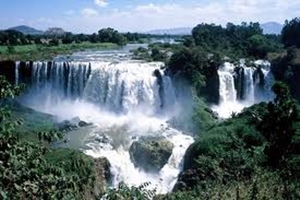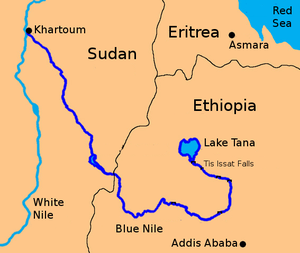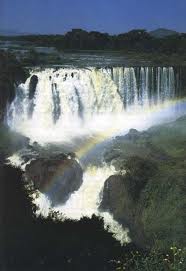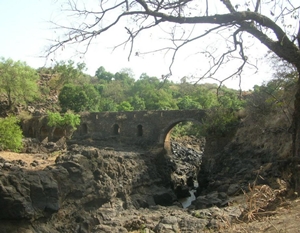
The Blue Nile River

The Blue Nile, locally known as Abbay, is the major tributory of the great Nile river - the longest river in the world. The Blue Nile river starts from Ethiopia's lake Tana and merges with the smaller tributory White Nile at Khartoum Sudan to form the Nile River. The mysterious Nile was long hidden from Western geographers and explorers. It was not until the expeditions of such great travellers as Bruce, Burton, and Speke that the secret of this grand river—which had fascinated, and eluded, even the ancient Romans and Greeks - was revealed. It was then confirmed that the White Nile originates in East Africa's Lake Victoria, while the Blue Nile pours out of Ethiopia's Lake Tana.

The Blue Nile flows generally south from Lake Tana and then west across Ethiopia and northwest into Sudan. Within 30 kilometres (19 miles) of its source at Lake Tana, the river enters a canyon about 400 kilometres (250 miles) long. This gorge is a tremendous obstacle for travel and communication from the north half of Ethiopia to the southern half. As it plunges more than 2,000 metres (6,560 feet) in its 800-kilometres (497-miles) course from Ethiopia to the Sudanese plains, the Blue Nile is what embodies the drama and mystery of the great river of history. The power of the Blue Nile may best be appreciated at Tis-Isat Falls, which are 45 metres (148 ft) high, located about 40 kilometres (25 miles) downstream of Lake Tana.

Known locally as Tis-Isat- 'Smoke of Fire' - the Blue Nile Falls are the most dramatic spectacle that the whole Nile system has to offer. Four hundred metres (1,312 feet) wide when in flood (which normally occurs in September and October, after the rainy season), and dropping over a sheer chasm more than forty-five metres (150 feet) deep, the falls throw up a continuous spray of water droplets which drench onlookers up to a kilometre away. This misty deluge, in turn, produces rainbows that shift and shimmer across the gorge and a perennial rainforest of lush green vegetation - much to the delight of the innumerable monkeys and multi-coloured birds that inhabit the gorge.

It is only a five-minute drive from the lakeside town of Bahir Dar across the Blue Nile Bridge, to the spot where the famous river flows out of Lake Tana. But the falls are about 40 kilometres (25 miles) south of the town and are best approached from Tis-Isat village, a market settlement of the Amhara people who live in this area farming crops like wheat, sorghum and teff (from which injera, the national bread, is made).
On leaving the village the footpath meanders first beside fertile open fields, then drops into a deep basaltic rift spanned by an ancient, fortified stone bridge built in the seventeenth century by Portuguese adventurers and still in use. After about a thirty-minute walk, a stiff climb up a grassy hillside is then rewarded by a magnificent view of the falls, breaking the smooth edge of the rolling river into a thundering cataract of foaming white water.




